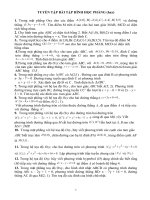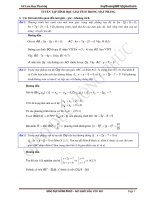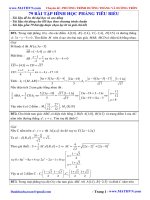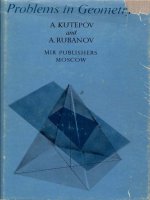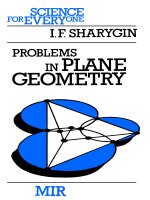problems in plane geometry (bài tập hình học phẳng) bởi i. f. sharygin
Bạn đang xem bản rút gọn của tài liệu. Xem và tải ngay bản đầy đủ của tài liệu tại đây (14.16 MB, 412 trang )
Science
for Everyone
0.«1».
maplllrHB
3a~aqH
no
reOMeTpHH
TIJIaHHMeTpHH
HSJUlTeJlbCTBO
tHayKa~,
MOCKB8
I.F. Sharygin
Problems in Plane Geometry
Mir
Publishers
Moscow
Translated from Russian
by Leonid Levant
First published 1988
Revised from the 1986 Russian edition
m
17020'0000-304
21-88
2
056(01)-88
'
••
Ha ane uucIWM
Jl.awlCe
Printed
In the Union of Soviet Soetalis;
Republic.
@ HSAateJIbCTBO
4lHayxat
I'nasaaa peAaxD;HJI t!»B8HKo-Ma-
TeM8TB1fOOKOii
JlHTepaTypw,
t986
@ English translation,
Mir
Publishers, 1988
ISBN
5-03-000180-8
Contents
Preface to the English
Edition
. 6
Section t. Fundamental Geometrical Facts
and Theorems. Computational
Problems . . .
8
Section 2. Selected Problems
and
Theo-
rems of Plane Geometry 65. Car-
not's
Theorem 65. Ceva's and
Menelaus'
Theorems. Affine Prob-
lems
70. Loci of Points 82.
Triangles. A
Triangle
and a
Circle 89. Quadrilaterals tt7.
Circles aod
Tangents. Feuer-
bach's
Theorem t29. Combina-
tions
of Figures.
Displacements
in
the
Plane.
Polygons t37. Geo-
metrical Inequalities. Problems
on Extrema
147
Answers, Hint!, Solutions
too
Section t too
Section 2 . . . 214
Appendix. Inversion 392
Preface to the English Edition
This is a translation from the revised
edition of
the
Russian book which was
issued in 1982.
It
is- actually
the
first in
a two-volume work on solving problems in
geometry, the second volume "Problems in
Solid Geometry" having been published in
English first by Mir Publishers in
~986.
Both volumes are designed for school-
children and teachers.
This volume contains over 600 problems
in plane geometry
and"
consists of two
parts. The first
part
contains
rather
simple
problems to be solved in classes and at
home. The second
part
also contains
hints
and detailed solutions. Over
~OO
new prob-
lems have been added to
the
1982 edition,
the simpler problems in
the
first addition
having been eliminated, and a number of
new sections- (circles and tangents, poly-
gons, combinations of figures, etc.) having
been introduced, The general structure of
the
book has been changed somewhat to
accord
with
the new, more detailed, clas-
sification of the problems. As a result, all
the problems in
this
volume have been
rearranged.
Although the problems in this collection
vary in "age" (some of them
can be found
in old books and journals, others were
offered
at
mathematical olympiads or pub-
lished in the journal "Quant" (Moscow»,
I
still
hope
that
some of the problems in
Preface
this
collection will be of interest to expe-
rienced geometers.
Almost every geometrical problem is non-
standard
(as compared
with
routine exer-
cises on solving equations, inequalities,
etc.): one has to
think
of
what
additional
constructions must be made, or which for-
mulas and theorems
must
be used. There-
fore,
this
collection cannot be regarded as
a problem-book in geometry;
it
is
rather
a
collection
of geometrical puzzles aimed
at
demonstrating
the
elegance of elementary
geometrical techniques of proof and methods
of computation (without using vector alge-
bra
and
with
a minimal use of
the
method
of coordinates, geometrical transforms-
tions, though a somewhat wider use of trig-
onometry).
In
conclusion, I should like to
thank
A.Z. Bershtein who assisted me in prepar-
ing
the
first section of
the
book for print.
I am also grateful to A.A. Yagubiants who
let
me know several elegant geometrical
facts.
The Author
Section 1
Fundamental Geometrical Facts
and Theorems.
Computational Problems
t.
Prove
that
the
medians in a triangle
intersect at one point (the median point)
and are divided
by
this
point
in
the
ratio
1 : 2.
•2. Prove
that
the
medians separate the
triangle
into
six equivalent parts.
3. Prove
that
the
diameter of the circle
circumscribed
about
a triangle is equal
to
the
ratio
of
its
side to
the
sine of
the
opposite angle.
4.
Let
the vertex of an angle be located
outside a circle, and
let
the
sides of the
angle intersect
the
circle. Prove
that
the
angle is measured by
the
half-difference of
the arcs inside
the
angle which are
cut
out
by
its
sides on
the
circle.
5.
Let
the vertex of an angle lie inside
a circle. Prove
that
the angle is measured
by the half-sum of
the
arcs one of which
is enclosed between
its
sides and the other
between
their
extensions.
6.
Let
AB
denote a chord of a circle, and
l
the
tangent
to
the
circle at the point
A.
Prove
that
either of
the
two angles between
AB
and l is measured by
the
half-arc of the
Sec. f. Fundamental Facts
9
circle enclosed inside
the
angle
under
con-
sideration.
7.
Through
the
point
M located
at
a dis-
tancea from
the
centre
of a circle of
radius
R
(a >
R),
a
secant
is
drawn
intersecting
the
circle
at
points A
and
B. Prove
that
the
product
I
MA
1·1
MB
J is
constant
for
all
the
secants and
equals
a
2
-
R2 (which is
the
squared
length
of
the
tangent).
8. A chord
AB
is
drawn
through
the
point
M
situated
at
a distance a from
the
centre
of a circle of
radius
R (a <
R).
Prove
that
I
AM
I-I
MB
Iis
constant
for
all
the
chords
and
equals RI - a
2
•
9.
Let
AM
be an angle bisector
in
the
triangle
ABC.
Prove
that
IBM
I:
I
CMf
=
I
AB
I I
AC
I.
The
same is
true
for
the
bisector of
the
exterior angle of
the
triangle.
(In
this
case
the
.point M lies on
the
extension of
the
side
Be.)
10.
Prove
that
the
sum
of
the
squares of
the
lengths of
the
diagonals of a parallelo-
gram
is
equal
to
the
sum
of
the
squares of
the
lengths of
its
sides.
1t.
Given
the
sides of a
triangle
(a, b,
and
e). Prove
that
the
median
mel
drawn to
the
side a
can
be computed by
the
formula
m
a
=
~
V2lJ2+ 2c
2-a
2
•
12.
Given two triangles
having
one ver-
tex
A in common,
the
other
vertices being
situated
on two
straight
lines passing
10 Problems in Plane Geometry
through
A.
Prove
that
the
ratio
of the areas
of these triangles is equal to
the
ratio of
the
products of the two sides of each triangle
emanating from
the
vertex A.
13. Prove
that
the
area of the circum-
scribed polygon is equal to
rp,
where r
is the radius of the inscribed circle and p
its
half-perimeter (in particular, this for-
mula holds true for a triangle).
14. Prove
that
the
area of a quadrilateral
is equal to half the product of
its
diagonals'
and
the
sine of the angle between them.
'-
15. Prove
the
validity
of the following
formulas for
the
area of a triangle:
a
l
sin B
sin
C
2
S =
2.
A'S
= 2R
SID
A
SID
B sm C,
sm
where
A,
B, C are
its
angles, a is the side
lying opposite
the
angle
A,
and R is
the
radius of
the
circumscribed circle.
16. Prove
that
the radius of the circle
inscribed in a
right
triangle can be com-
a+b-c
puted by
the
formula r = 2 '
where a and b are the legs and c is
the
hypotenuse.
17. Prove
that
if a and b are two sides of
a triangle,
a
the
angle between them, and l
the bisector of this angle, then
(£
2abc08
T
1=
a+b
Sec. 1. Fundamental Facts
it
18. Prove
that
the
distances from
the
vertex A of
the
triangle
ABC
to
the
points
of tangency of
the
inscribed circle with
the
sides
AB
and
AC
are equal to p - a (each),
where
p is
the
half-perimeter of
the
triangle
ABC,
a = I
BC
I.
19. Prove
that
if in a convex
quadrilat-
eral
ABeD
I
AB
I + I CD I = IAD I +
I
BC
I,
then
there is a circle touching
all
of
its
sides.
20. (a) Prove
that
the
altitudes
in a
triangle
'are
concurrent
(that
is intersect
at
one point). (b) Prove
that
the distance
from
any
vertex of a
triangle
to
the
point
of intersection of
the
altitudes
is twice
the
distance from
the
centre of the cir-
cumscribed circle to
the
opposite side.
• • •
21.
Points
A
and
B are
taken
on one side
of a
right
angle
with
vertex 0 and
lOA
I =
a, I OB I = b.
Find
the
radius
of
the
circle
passing through
the
points A and
Band
touching
the
other
side of
the
angle.
22. The hypotenuse of a
right
triangle
is
.equal to c, one of
the
acute angles being
30°.
Find
the
radius
of
the
circle with
centre
at
the
vertex of
the
angle of 30°
which separates
the
triangle into two
equi
v-
alent
parts.
23.
The
legs of a
right
triangle
are a
and
b.
Find
the
distance from
the
vertex of
the
t2
Problems in Plane Geometry
right
angle to
the
nearest point of
the
inscribed circle.
24. One of
the
medians of a
right
triangle
is
equal
to m and divides the
right
angle
in
the
ratio
1 : 2.
Find
the area of
the
triangle.
25. Given in a triangle
ABC
are three
sides:
I
Be
I = a, I CA I = b, I
AB
I = c.
Find
the
ratio
in which
the
point of inter-
section of
the
angle bisectors divides
the
bisector of
the
angle B.
26. Prove
that
the
sum of
the
distances
from any
point
of
the
base of an isosceles
triangle to
its
sides is equal to
the
altitude
drawn to either of
the
sides.
1:1.
Prove
that
the
sum of distances from
any point inside an equilateral triangle
to
its
sides is equal to
the
altitude
of
this
triangle.
28.
In
an isosceles triangle ABC, taken
on
the
base AC is a point M such
that
I
AM
I = a, I
Me
I = b. Circles are in-
scribed in
the
triangles
ABM
and
CBM.
Find
the
distance between
the
points
at
which these circles touch
the
side
BM.
29.
Find
the area of
the
quadrilateral
bounded by
the
angle bisectors of a paral-
lelogram
with
sides a and b and angle Ct.
30. A circle is inscribed in a rhombus
with
altitude
h and acute angle
C%.
Find
the radius of
the
greatest of two possible
circles each of which touches
the
given
circle and two sides of
the
rhombus.
Sec. 1. Fundamental Facts
13
3t
. Determine the acute angle of the
rhombus whose side is the geometric
mean
of
its
diagonals.
32. The diagonals of a convex quadrilat-
eral are equal to
a and b, the line segments
joining the midpoints of the opposite sides
are congruent. Find
the area of the quadri-
lateral.
33. The side
AD
of the rectangle ABCD
is three times the side
AB;
points M and
N divide
AD
into three equal parts. Find
LAMB
+
LANB
+
LADB.
34. Two circles intersect
at
points A
and B. Chords A C and
AD
touching the
given circles are drawn through the point
A.
Prove
that
lAC
1
2.1
BD I = I
AD
1
2
•
IBC
I.
35. Prove
that
the bisector of the right
angle in a right triangle bisects the angle
between the median and
the
altitude drawn
to the hypotenuse.
36. On a
circle of radius r, three points
are chosen
80
that
the circle is divided
into three arcs in
the ratio 3 : 4 : 5. At the
division points, tangents are drawn to the
circle. Find the area of the triangle formed
by the tangents.
37. An equilateral trapezoid is circum-
scribed about a circle,
the
lateral side of
the trapezoid is
I, one of
its
bases is equal
to
4.
Find the area of the trapezoid.
38. Two straight lines parallel to the
bases of a trapezoid divide each lateral
14
Problems in Plane Geometry
side into three equal parts. The entire
trapezoid is separated by the lines into
three parts. Find the area of the middle
part
if the areas of the upper and lower
parts are 8
1
and S2' respectively.
39. In
the
trapezoid ABCD I
AB
I = a,
IBC I = b (a
=1=
b). The bisector of the
angle
A intersects either the base BC or the
lateral side
CD. Find out which of them?
40. Find the length of the line segment
parallel to
the
bases of a trapezoid and
passing through the point of intersection
of
its
diagonals if
the
bases of the trapezoid
are
a and b.
41. In an equilateral trapezoid circum-
scribed about
8 circle,
the
ratio
of
the
parallel sides is k. Find
the
angle
at
the
base.
42.
In
a trapezoid
ABCD,
the base
AB
is equal to a, and
the
base CD to b. .Find
the area of
the
trapezoid if the diagonals
of the trapezoid are known to be
the
bisec-
tors of the angles
DAB
and ABC.
43.
In
an equilateral trapezoid, the mid-
line is equal to
a, and the diagonals are
mutually perpendicular. Find the area of
the trapezoid.
44. The area of an equilateral trapezoid
circumscribed about a circle is equal to
S,
and the
altitude
of the trapezoid is half
its
lateral side. Determine
the
radius of
the
circle inscribed in the trapezoid.
45. The areas of
the
triangles formed by
Sec. f. Fundamental Facts
i5
the segments of
the
diagonals of a trapezoid
and
its
bases are equal to 8
1
and 8
1
•
Find
the area of the trapezoid.
46. In a triangle
ABC,
the angle
ABC
is
tX. Find the angle AOe, where 0 is the
centre of the inscribed circle.
47. The bisector of the
right
angle is
drawn in a
right
triangle. Find the distance
between the points of intersection of the
altitudes of the triangles thus obtained,
if the legs of the given triangle are
a and b.
48. A straight line perpendicular to two
sides of a parallelogram divides the
latter
into two trapezoids in each of which a
circle can .be inscribed. Find the acute
angle of the parallelogram if its sides are
a and b (a < b). .
49. Given a half-disc with diameter
AB.
Two
straight
lines are drawn through the
midpoint of the semicircle which divide
the half-disc into three equivalent areas.
In what ratio is the diameter
AB
divided
by these lines?
50. A square
ABCD
with side a and two
circles are constructed. The first circle is
entirely inside the square touching the side
AB
at a point E and also the side
Be
and
diagonal
AC. The second circle with centre
at
A passes through
the
point E. Find
the area of the common
part
of the two
discs bounded by these circles.
51. The vertices of a regular hexagon
with side
a are the centres of the circles
16
Problems in Plane
Geometry
with
radius
a/y'2.
Find
the
area of
the
part
of
the
hexagon
not
enclosed
by
these
circles.
52. A
point
A is
taken
outslde a circle
of
radius
R. Two secants are drawn from
this
point: one passes through
the
centre,
the
other
at
a distance of R/2 from
the
centre.
Find
the
area of
the
region enclosed
between these
secants.
53. In a
quadrilateral
ABeD:
LDAB
=
90°,
LDBC
=
90°.
IDB I= a,
and
IDC
1=
b.
Find
the
distance between
the
centres
of two circles one of which passes through
the
points
D, A
and
B,
the
other
through
the
points B, C,
and
D.
54.
On
the
sides
AB
and
AD of
the
rhombus ABCD points M
and
N are
taken
such
that
the
straight
lines
Me
and
NC
separate
the
rhombus
into
three
equivalent
parts.
Find
I
MN
I if IBD I = d.
55.
Points
M and N are
taken
on
the
side
AB
of a triangle
ABC
such
that
lAM
I:
I
MN
I:
INB
I =
1:
2 : 3.',Through
the
points
M
and
N
straight
Iines are
drawn
parallel
to tHe side AC.
Find
the
area of
the
part
of
the
triangle
enclosed
between these lines if
the
area of
the
triangle
ABC
is
equal
to S.
56. Given a circle and a
point
A located
outside of
this
circle,
straight
lines
AB
and
AC
are
tangent
to
it
(B and C
points
of tangency).
Prove
that
the
centre of
the
Sec.
t.
Fundamental
Facts
i7
circle inscribed in
the
triangle
ABC
lies
on
the
given circle.
57. A circle is circumscribed about
an
equilateral
triangle ABC, and an
arbitrary
point
M is
taken
on
the
arc BC. Prove
that
I
AM
I = I
EM
I + I CM
I·
58.
Let
H be
the
point
of intersection of
the
altitudes
in a triangle
ABC.
Find
the
interior
angles of
the
triangle
ABC
if
LBAH
= a,
LABH
=
~.
59.
The
area of a rhombus is equal to S,
the sum of
its
diagonals is m,
Find
the
side
of
the
rhombus.
60. A square
with
side a is inscribed in
a circle.
Find
the
side of
the
square in-
scribed in one of
the
segments
thus
ob-
tained.
61. In a 120
0
segment of a circle
with
altitude
h a rectangle
ABCD
is inscribed
so
that
I
AB
I : I BC I = 1 4 (BC lies
on
the
chord). Find
the
area of
the
rect-
angle.
62. The area of an
annulus
is equal to S.
The
radius
of
the
larger circle is equal to
the
circumference of
the
smaller.
Find
the
radius
of
the
smaller
circle.
63. Express
the
side of a regular decagon
in terms of
the
radius
R of
the
circumscribed
circle.
64. Tangents
MA and
MB
are
drawn
from an exterior
point
M to a circle of
radius
R forming an angle a. Determine
2-01557
18
Problems in Plane Geometry
the
area of
the
figure bounded by the
tan-
gents and
the
minor arc of the circle.
65. Given a square
ABCD
with side a.
Find
the
centre of
the
circle passing
through
the
following points:
the
midpoint
of the side
AB,
the
centre of the square,
and
the
vertex C.
66. Given a rhombus
with
side a and acute
angle
Ct.
Find
the
radius of
the
circle pass-
ing through two neighbouring vertices of
the
rhombus and touching
the
opposite
side of
the
rhombus or
its
extension.
67. Given three pairwise tangent circles
of radius
r. Find
the
area of
the
triangle
formed by three lines each of which touches
two circles and does
not
intersect
the
third
one.
68. A circle of radius r touches a
straight
line
at
a
point
M.
Two, points A
and
B
are chosen on this line on opposite sides of
M such
that
I
MAl
=
1MB
I = a. Find
the
radius of
the
circle passing through A
and B and touching the given circle.
69. Given a square
ABCD
with side a.
Taken on
the
side BC is a
point
M such
that
I
BM
I = 3 I MC I and on
the
side CD a
point
N such
that
2 ICN I = I ND
I.
Find
the radius of
the
circle inscribed in
the
triangle
AMN.
70. Given a square
ABeD
with
side a.
Determine
the
distance between
the
mid-
point of
the
line segment
AM,
where M is
Sec. 1. Fundamental Facts
19
the
midpoint
of
Be,
and a point N on the
side
CD such
that
I CN I I ND I = 3 1.
71. A
straight
line emanating from the
vertex
A in a triangle
ABC
bisects the
median
BD (the point D lies on
the
side
AC).
What
is the
ratio
in which
this
line
divides the side
BC?
72.
In
a
right
triangle
ABC
the leg CA
is equal to b, the leg
eB
is equal to a, CH
is
the
altitude,
and
AM
is the median.
Find
the
area of the triangle
BM
H.
73. Given an isosceles triangle
ABC
whose
LA
= a > 90° and I
Be
I = a. Find
the
distance between
the
point of intersection
of
the
altitudes
and
the
centre of
the
cir-
cumscribed circle.
74. A circle is circumscribed about a
triangle
ABC
where I BC I = a,
LB
=
a,
LC
=
p.
The bisector of the angle A meets
the
circle
at
a point K. Find I
AK
I.
75. In a circle of radius R, a diameter is
drawn
with
a point A
taken
at
a distance
a from
the
centre. Find
the
radius of another
circle which is tangent to
the
diameter
at
the
point
A and touches
internally
the
given circle.
76.
In
a circle, three pairwise intersecting
chords are drawn. Each chord is divided
into
three equal
parts
by
the
points of
intersection. Find the radius of
the
circle
if one of the chords is equal to a.
77. One regular hexagon is inscribed in
a circle,
the
other
is circumscribed about
2*
20
Problems in Plane Geometry
it.
Find
the
radius
of
the
circle if
the
differ-
ence between
the
perimeters of these hexa-
gons is
equal
to a.
78.
In
an
equilateral
triangle
ABC
whose
side is
equal
to a,
the
altitude
BK
is drawn.
A circle is inscribed
in
each of
the
triangles
ABK
and
BCK,
and
a common
external
tangent,
different from
the
side AC, is
drawn
to them.
Find
the
area of
the
triangle
cut
off by
this
tangent
from
the
triangle
ABC.
79. Given
in
an inscribed
quadrilateral
ABCD are
the
angles:
LDAB
= a,
LABC=
p,
LBKC
= y, where K is
the
point
of
intersection
of
the
diagonals.
Find
the
angle ACD.
80.
In
an inscribed
quadrilateral
ABeD
whose diagonals
intersect
at
a
point
K,
lAB
I = a,
18K
1=
b,
IAK
1=
c, I
CDI=
d.
Find
I
AC
I.
8t. A circle is circumscribed
about
a
trapezoid.
The
angle between one of
the
bases of
the
trapezoid
and
a
lateral
side
is
equal
to
ex
and
the
angle between
this
base
and
one of
the
diagonals is
equal
to
p.
Find
the
ratio
of
the
area of
the
circle to
the
area of
the
trapezoid.
82.
In
an
equilateral
trapezoid
ABCD,
the base
AD
is
equal
to a,
the
base
Be
is
equal
to b, I
AB
I = d.
Drawn
through
the
vertex
B is a
straight
line
bisecting
the
diagonal
AC
and
intersecting
AD
at
a
point
K.
Find
the
area of
the
triangle
BD
K .
83.
Find
the
sum
of
the
squares of
the
Sec. 1. Fundamental Facts
21
distances
from
the
point
M
taken
on a
diam-
eter
of a
circle
to
the
end
points
of any
chord
parallel
to
this
diameter
if
the
radius
of
the
circle is R,
and
the
distance
from M
to
the
centre
of
the
circle
is a.
84. A common
chord
of two
intersecting
circles
can
be observed
from
their
centres
at
angles of 90°
and
60°.
Find
the
radii
of
the
circles if
the
distance
between
their
centres
is
equal
to a.
85.
Given
a
regular
triangle
ABC. A
point
K divides
the
side
A C in
the
ratio
2 : 1,
and
a
point
M
divides
the
side
AB
in
the
ratio
t 2 (as measured from
the
vertex
A
in
both
cases).
Prove
that
the
length
of
the
line
segment
KM
is
equal
to
the
radius
of
the
circle
circumscribed
about
the
triangle
ABC.
86. Two circles of
radii
Rand
R/2
touch
each
other
externally.
One of
the
end
points
of
the
line
segment
of
length
2R forming
an angle of
30°
with
the
centre
line
coincides
with
the
centre
of
the
circle
of
the
smaller
radius.
What
part
of
the
line
segment
lies
outside
both
circles? (The
line
segment
intersects
both
circles.)
87. A
median
BK,
an angle bisector
BE,
and
an
altitude
AD
are
drawn
in a
triangle
ABC.
Find
the
side
AC
if
it
is known
that
thelines
EX
and
BE
divide
the
line
segment
AD
into
three
equal
parts
and
I
AB
I = 4.
88.
The
ratio
of
the
radius
of
the
circle
inscribed in an isosceles
trrangle
to the
22 Problems in
Plane
Geometry
radius of the circle circumscribed about
this
triangle is equal to k.
Find
the base angle
of the triangle.
89. Find the cosine of the angle at the
base of an isosceles triangle if the point of
intersection of
its
altitudes lies on the circle
inscribed in the triangle.
90. Find the area of the pentagon bounded
by the lines
BC, CD,
AN,
AM,
and
BD,
where
A,
B, and D are the vertices of a
square
ABCD,
N the midpoint of the side
BC,
and M divides the side CD in the
ratio
2 : 1 (counting from the vertex C) if the
side of the square
ABCD
is equal to a.
91. Given in a triangle
ABC:
LBAC
=
a,
LABC
=~.
A circle centred
at
B
passes through A and intersects the line
AC
at a point K different from
A,
and
the
line
Be
at points E and F. Find the angles of
the
triangle E
KF.
92. Given a square with side a. Find the
area of
the
regular triangle one of whose
vertices coincides with the midpoint of one
of the sides of the square, the other two
lying on the diagonals of the square.
93. Points
M,
N, and K are taken on the
sides of a square
ABeD,
where M is the
midpoint of
AB,
N lies on the side BC
(2 I
BN
I = I
NC
I). K lies on
the
side
DA
(2 I
DK
I = I
KA
I). Find the sine
of
the
angle between the lines MC and N K.
94. A circle of radius r passes through the
vertices A and B of the triangle
ABC
and
